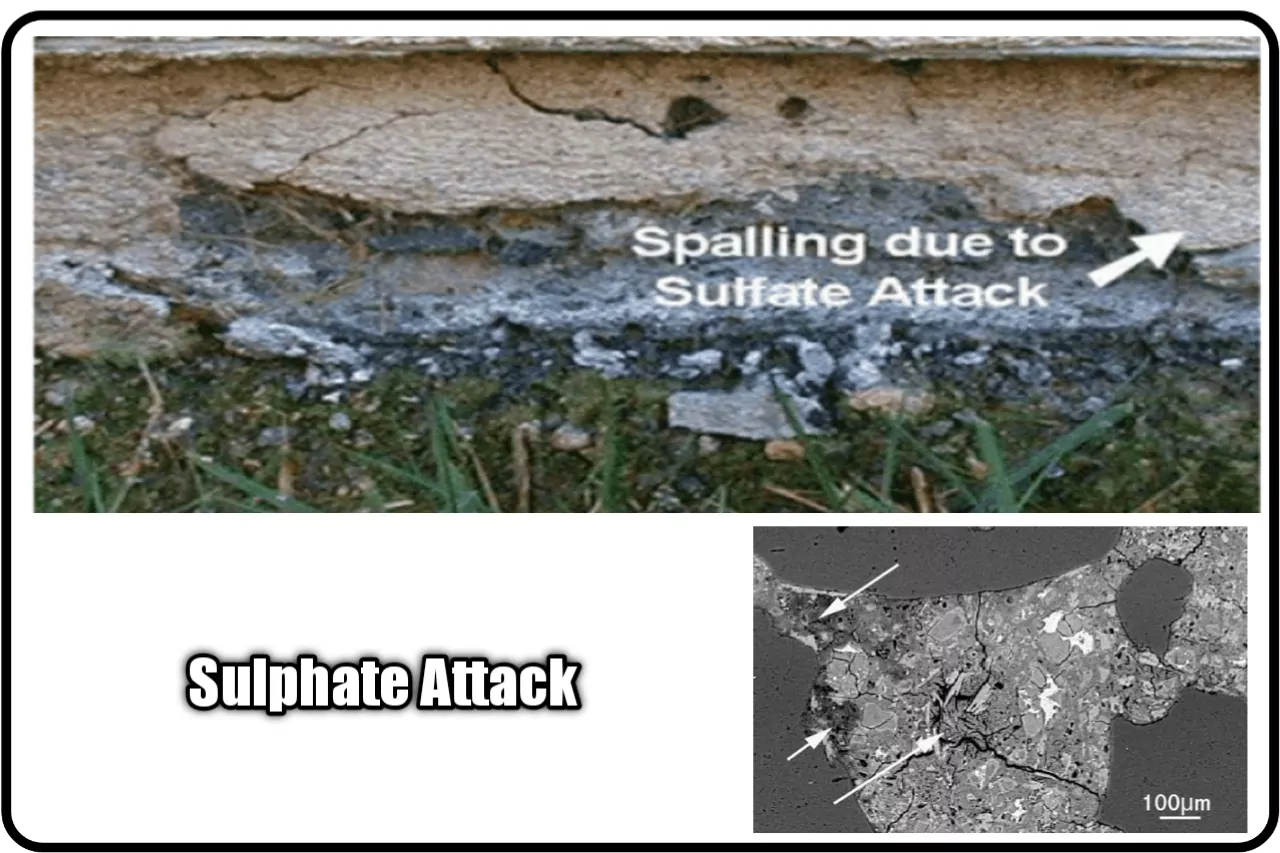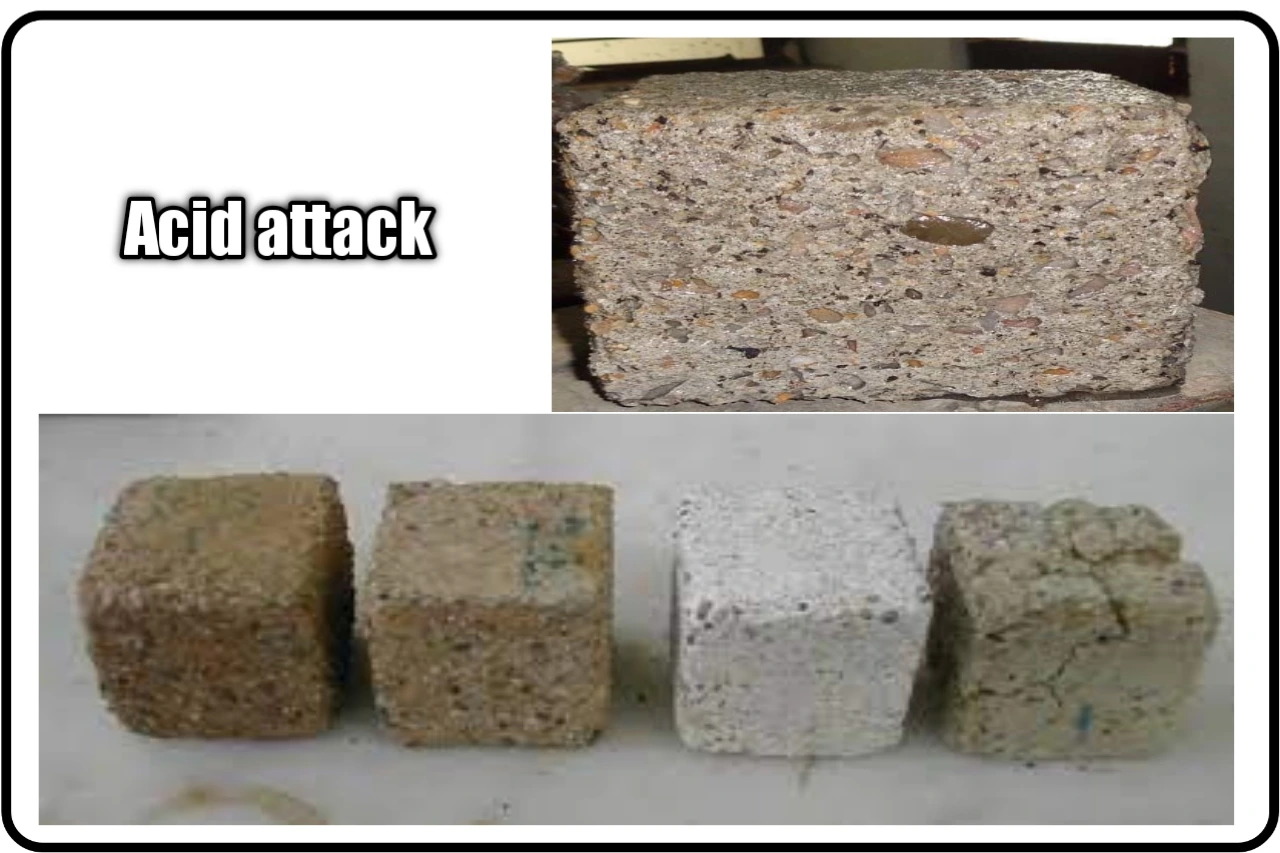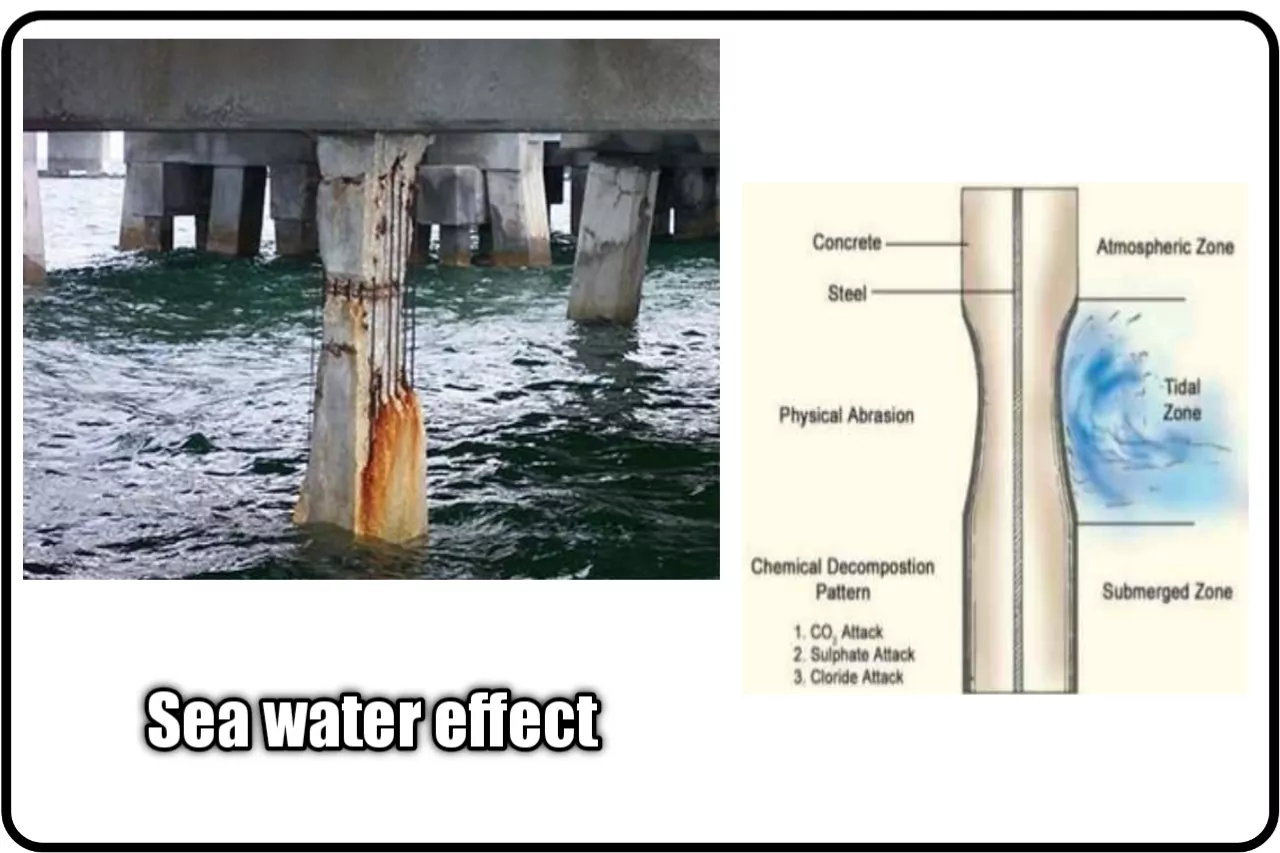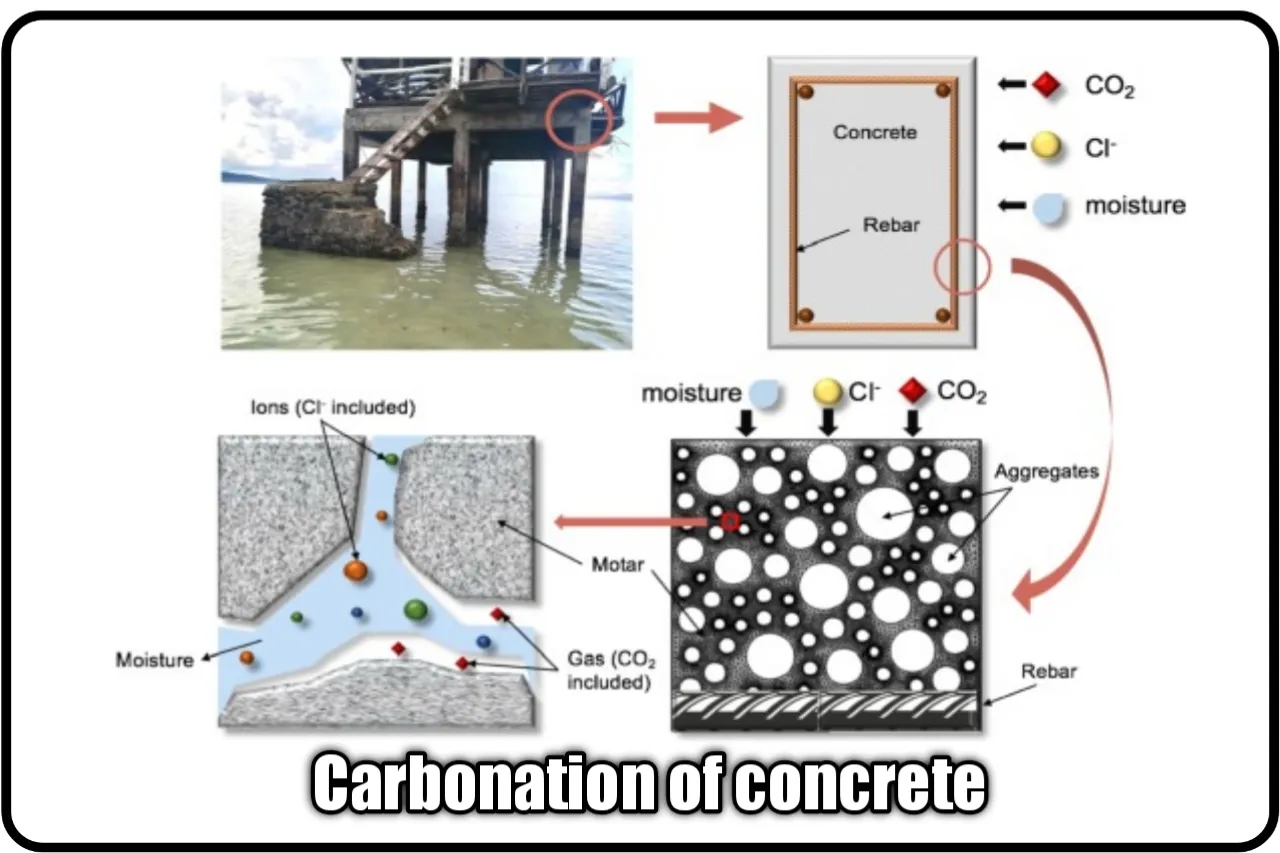The durability of Portland cement is defined as its ability to resist weathering action chemical attack, abrasion, or any other process of deterioration; that is durable concrete will retain its original form, quality, and serviceability when exposed to its environment.
It is generally accepted now that in designing structures the durability characteristics of the materials under consideration should be evaluated as carefully as other aspects such as mechanical properties and initial cost Increasingly, repair and replacement costs of structures arising from material failures have become a substantial portion of the total construction budget.
In many developed countries like the USA, UK, Japan, Switzerland, etc., over 40% of the total resources of the building industry are applied to repair and maintenance of existing structures, and less than 60 percent to new construction.
The durability of concrete depends on its resistance to deterioration and the environment in which it is placed. The resistance of concrete to weathering, chemical attack, abrasion, frost, and fire depends largely upon its quality and constituent materials, Susceptibility to corrosion of the steel is governed by the cover provided and the permeability of concrete, The cube crushing strength alone is not a reliable guide to the quality and durability of concrete it must also have an adequate cement content and a low water-cement ratio.
RCC is a composite structural material, which has not proved to be durable due to large the number of factors like :
♦ Variations in production.
♦ Loading conditions in service life
♦ Attack by environmental factors, etc.
However, a well proportioned, properly compacted, and cured concrete used in RCC continues to be substantially watertight and durable as long as capillary pores and microcracks in the interior do not become interconnected pathways leading to the surface of the concrete.
FACTORS AFFECTING DURABILITY
External factors
- Physical, chemical, or mechanical
- Environmental, such as extreme temperatures, abrasion, and electrostatic action
- Attack by natural or industrial liquids and gases.
Internal factors
- Permeability of concrete
- Alkali aggregate reaction
- Volume changes due to difference in thermal properties of the aggregate and cement paste
PHYSICAL CAUSES OF DETERIORATION OF CONCRETE
- Cracking
- Surface water
(1) Cracking
Cracking are cause due to following reasons…
1.Structural loading
- overloading
- impact loading
- cyclic loading
2.Exposure to temprature
- Fire
- Freeze and thawing process
3.Volumn change due to
- Temperatures change
- Humidity change
- De-icing process
(2) Surface water
Surface water in the concrete is divided into the following parts
- Abrasion
- Cavitation
- Erosion
REQUIREMENT FOR DURABILITY OF CONCRETE :
We shall discuss the requirements for durability under following heads
- Exposure conditions
- General environment
- Freezing and thawing
- Exposure to sulfate attack
- Acid attack
- Seawater attack
- Abrasion, erosion, and cavitation
- Carbonation
- ALKALI AGGREGATE REACTION
2. Requirement of concrete cover
3. Shape and size of member
4. Type and quality of constituent materials
- Concrete mix proportions
- Maximum cement -content
- Chloride in concrete
- Sulphate in concrete
- Alkali aggregate reaction
5. Compaction, finishing and curing of concrete
1. Exposure Conditions:
1.General Environment condition

The general environment to which the concrete will be exposed during its working life is classified into five levels of severity, namely, mild, moderate, severe, very severe, and extreme as described in the table.
| NO | Environment | Exposure condition |
| 1 | Mild | Concrete surfaces protected against weather or aggressive conditions, except those situated in the coastal areas. |
| 2 | Moderate | Concrete surfaces sheltered <from seVere rain or freezing whilst wet concrete exposed to condensation and rain. Concrete in contact or buried under non-aggressive soil/groundwater, concrete continuously underwater, concrete surfaces sheltered from saturated salt air in the coastal areas. |
| 3 | Severe | Concrete surfaces exposed to severe rain, alternate wetting, and drying or occasional freezing whilst wet or severe condensation. Concrete completely immersed in seawater. Concrete exposed to the coastal environment. |
| 4 | Very Severe | Concrete surfaces exposed to seawater spray, corrosive fumes, or severe freezing conditions whilst wet. Concrete in contact with or buried under aggressive subsoil/groundwater. |
| 5 | Extreme | The surface of members in the tidal zone. Members in direct contact with liquid/ solid aggressive chemicals. |
2.FREEZING AND THAWING
Resistance to weathering is an important consideration in severe climatic conditions. The lack of durability of concrete due to freezing and thawing of frost is hot so important in Indian conditions. But It is of great importance in cold countries.

As the temperature of saturated hardened concrete is lowered, the water held in the capillary pores in the cement paste freezes in a manner similar to the freezing in the capillaries in rock, and expansion of the concrete takes place. If subsequent thawing is followed by re-freezing, further expansion of concrete takes place. Hence, if the concrete mass is subjected to alternate cycles of freezing and thawing, it has a detrimental effect on the strength of concrete.
Fresh concrete contains a considerable quantity of free water, If such concrete is subjacent to freezing temperature, discrete ice lenses are formed. Water expands about 9% in volume during freezing so that the excess water in the cavity is expelled. The hydraulic pressure developed will depend upon the resistance to flow, i.e. on the length of the path and the permeability of the paste between the freezing cavity and a void that can accommodate the excess water.
The formation of ice lenses formed in the body of fresh concrete disrupts the fresh concrete causing nearly permanent damage to concrete. Such concrete, will not recover the structural integrity if later on allowed to harden at a temperature higher than the freezing temperature. Hence, while concreting in cold weather, the temperature of the fresh concrete should be maintained above 0°C.

For fully hardened concrete, subjected to alternate cycles of freezing and thawing, the severest conditions for frost action arise when concrete has more than one face exposed to the weather and it remains wet for long period. For example, parapets, road curbs, concrete members in hydraulic structures just above water level, etc. It has been estimated that the freezing of water in the hardened concrete may exert a pressure of about 14 MPa, If the hydraulic pressure, so generated exceeds the tensile strength of the concrete, cracks are developed in the concrete.
Freezing starts at the surface in the largest cavities and gradually extends to smaller ones, Gel pores are too small to get it frozen till the temperature goes below – 78°C, so that in practice no ice is formed in the gel pores.
Where freezing and thawing actions under wet conditions exist, enhanced durability can be obtained by the use of suitable air entraining admixtures.
Since air entrainment reduces the strength of concrete, a suitable adjustment may be made in the mix design for achieving required strength.
Freeze and thawing mechanism :
(i) Freeze and thaw deterioration generally occur on horizontal surfaces that are exposed to water or on vertical surfaces that are at the water line in submerged portions of structures.
(ii) The freezing water in the pores expands (about 9% in volume) as it is convened into ice.
(iii) The expansion causes localized tension forces that fracture the surrounding concrete matrix.
(iv) Initially, fine closely spaced cracks are developed parallel to the edge of the exposed concrete.
(v) The cracks soon become filled with a dark deposit of calcium carbonate and are known as D-cracfa.
(vi) As the-deterioration continues small pieces of concrete between the cracks separate from the body of concrete.
Rate of freeze-thaw deterioration :
(i) Increased porosity – increases the rate
(ii) Increased moisture saturation – increases the rate
(iii) Increased number of freeze-thaw cycles – increases the rate
(iv) Horizontal surface that traps standing water – increases the rate
(v) Aggregate with small capillary structure and high absorption – increases the rate
(vi) Air entrainment -decreases the rate
Preventation measure for freezing and thawing
- Use of lowest practical w/c ratio
- Adequate air entrainment (4 to 5 %)
- Use of durable, nonporous aggregate
- Adequate curing of concrete prior to exposure to freezing and thawing.
- Providing proper drainage rather than flat surfaces.
3.SULPHATE ATTACK :
The sulphates of Calcium, Sodium, Potassium, and Magnesium are present in most soils and groundwater. Agricultural soil and water contain ammonium sulphate, from the use of fertilizers or from sewage and industrial effluents. Water used in concrete cooling towers can also be a potential source of sulphate attack. In marshy land, decay of organic matters leads to the formation of H2S, which is converted into sulphuric acid by bacteria.
Solid salts (sulphates) do not attack concrete, but when present in solution they can react with hardened cement paste. In the hardened concrete, sulphates react with the free calcium/hydroxide [Ca (OH)2]. to form gypsum (calcium sulfate).

Similarly, sulphates react with calcium aluminate hydrate (C-A-H) to form calcium sulphoaluminate, the volume of which is approximately 117% of the volume of the original aluminates. The produce of the reactions, gypsum, and calcium sulphoaluminate have a considerably greater volume than the compounds they replace so that the reactions with the sulphates lead to expansion and disruption of the concrete.

With the increase in the strength of the solution, the rate of sulphate attack increases. But beyond a concentration of about 0.5 percent of MgSO4 or 1 percent of Na2SO4 the rate of increase in the intensity of the attack becomes smaller. Attack of magnesium sulphate to concrete with a higher water/cement ratio can cause serious damage to concrete. However, if the concrete is made with a low water/cement ratio, the concrete can withstand the action of magnesium sulphate for 2 to 3 years.
In addition to the concentration of the sulphate, the speed with which concrete is attacked also influences the rate of sulphate attack. When concrete is exposed to the pressure of sulphate bearing water on one side, the rate of attack will be highest. Sulfate attack is greatly accelerated if accompanied by alternate wetting and drying, which normally takes place in marine structures in the zone of tidal variations. On the other hand, when concrete is completely buried, without a channel for the ground-water, conditions will be much less severe.
Preventation measure for sulphate attack
(1) Use of sulphate resisting cement
(2) Addition of Pozzolana
(3) Quality of concrete
(4) Use of air-entrainment
(5) High-Pressure steam curing
(6) Use of high-alumina cement
(7) Lining of polyethylene sheet
4.ACID ATTACK :
Concrete is used for the storage of many kinds of liquids, some of which are harmful to concrete. In industrial plants, concrete floors come in contact with acids, which damage the floor. In damp conditions SO2 and COo and, other acid fumes present in the atmosphere affect concrete by dissolving and removing part of the set concrete. This form of attack occurs in chimneys and steam railway tunnels. In fact, no Portland cement is acid-resistant.

Acid attack is encountered also under industrial conditions. Concrete is also attacked by water containing free CO£. Flowing pure water formed by melting ice or by condensation and containing little CO2, also dissolves Ca(OH)2 thus causing surface erosion. Sewerage water also very slowly causes the deterioration of concrete.
In Practice, acid attack occurs at values of PH below about 6.5, But the attack is severe only at a PH value below 5.5. At a PH value below 4.5, the attack is very severe, Under acid attack, cement compounds are eventually broken down and leached away, If acids or salts are able to reach the reinforcing steel through cracks or porosity of concrete, corrosion of reinforcement takes place.
5.SEA WATER ATTACK
Seawater contains sulphates and hence attacks concrete in a manner similar to the sulphate attack. Sea Water contains 3.5 percent of salt by weight. Its PH value varies between 7.5 to 8.4. Seawater also contains some amount of CO2
In addition to the chemical action, crystallization of the salts in the pores of the concrete may result in its disruption owing to the pressure exerted by the salt crystals. , Concrete between the tide marks, subjected to alternating wetting and drying, is severely attacked, while permanently immersed concrete is attacked least. In place of the cold climatic region, the freezing of water in pores at the spray level of concrete is responsible for causing a lack of durability OF concrete.

Seawater waves while approaching in the shallow end, holds a certain quantity of sand and silt. The velocity of waves causes the abrasion of concrete. The impact of sea waves also causes the deterioration of concrete.
In the case of reinforced concrete, the absorption of salt establishes anodic and cathodic areas, resulting in corrosion of reinforcement. The accumulation of the corrosion products on the steel causes rupture of the surrounding concrete. So that the effects of seawater are more severe on reinforced concrete than on plain concrete. It is, therefore, necessary to provide. a sufficient cover to reinforcement, preferably 75 mm.
6.ABRASION, EROSION AND CAVITATION
Abrasion refers `to the wearing away of the surface by friction. Erosion refers to the wearing away of the surface by the action of fluids. The cavitation refers to the damage due to non-linear the flow of water at velocities more than 12 m/sec.
Concrete floors and pavements are subjected to abrasion and impact, which results in the wear of. the surface during use. In the case of hydraulic structures, the action of the abrasive material carried by water generally leads to erosion. In the case of tunnels and dam spillways, the action of flowing water with large kinetic energy, damage the concrete by cavitation. Further, cavitation may occur in these structures. Cavitation also occurs in penstock pipes etc.

the higher the compressive strength of concrete, the higher is the resistance to abrasion. The hardness of coarse aggregate is also important to abrasion resistance. For coarse aggregates used in wearing surfaces, the Los Angeles abrasion value should not exceed 16 percent. Graded aggregate improves the wear resistance.

Wear resistance of concrete can be improved by adopting mixes of lower water/cement ratio and lowest practicable slump. The uniformity of the concrete also increases the wear resistance.

Overhanded mixes should not be used. If air-entrained concrete is used, the amount of entrained air should not be more than 4 percent. Absorptive cement’ blankets for floors and the use of absorptive form linings increase the resistance of concrete to wear. Over compacting of concrete and overworking of the top surface to get a smooth finish should be avoided.
7.CARBONATION
The carbon dioxide (CO ) present in the atmosphere reacts in the presence of water with hydrated cement minerals, converting calcium hydroxide [Ca(OH)2] to calcium carbonate [CaCO3]. The carbonation penetrates beyond the exposed surface of concrete only very slowly.

In the case of stronger concrete, the rate of carbonation depth will be slower. The permeability of concrete also affects the rate of carbonation. In permeable concrete carbonation penetrate at a faster rate, than in dense concrete. Concrete with a higher w/c ratio is more susceptible to carbonation. If the pores are dry i.e. if the relative humidity is low, the CO2 remains in the. gaseous form and does not react with the hydrated cement. The rate of carbonation is highest at a relative humidity of about 50 to 75 percent ’

The depth of carbonation can be measured by treating the freshly broken surface of the concrete with a solution of phenolphthalein in diluted alcohol. If Ca(OH)2 is unaffected by CO, the color of concrete will turns out to be pink. If concrete is carbonated it will remain uncolored. The PH value of pore water in the hardened cement paste which is around 13, will be reduced to around 9.0. due to carbonation. The pink color will show up to a PH value of about 9.5.
Concrete of good quality usually carbonates very slowly. Even after a period of 50 years, carbonation is to penetrate to a depth of about’5 to-10 mm. On the other hand, permeable concrete may carbonate to a depth of 25 mm in less than 10 years.

Carbonation reduced due to reduced moisture content and reduced CO2 concentration in the atmosphere.
8. ALKALI AGGREGATE REACTION
Normally, aggregates used in concrete are considered inert materials. But some of the aggregates contain a reactive type of silica, which reacts with alkalies present, in cement i.e. sodium oxide (Na2O) and potassium oxide (K2O). As a result^ the alkali silicate gels of unlimited swelling type are formed. This reaction is known. as ‘alkali-aggregate reaction’

The types of rocks which contain reactive constituents include traps, .andesite, rhyolites, siliceous limestones, and certain types of sandstones. The reactive constituents may be in the form of opals, cherts, volcanic glass, zeolite, chalcedony, etc.
The alkali-silica gel formed by the alkali-aggregate reaction is confined by the surrounding cement paste and internal pressure is developed leading to expansion, cracking, and disruption of cement paste. This expansion appears to be due to hydraulic pressure generated through osmosis, but can also be due to the swelling pressure of the still-solid products of alkali-silica reaction, This indicates that the swelling of the hard aggregate is most harmful to concrete.

The reactivity of aggregate depends upon its particle size and porosity as these influence the area over which the reaction can take place.
Measures to control alkali aggregate reaction
- Selection of non-reactive type of aggregates
- By restricting alkali content in cement below 0.6%.
- By controlling temperature.
- By controlling moisture condition.
- By the use of corrective admixtures such as pozzolanas.
- By controlling the void space in concrete
2.Requirement of Concrete Cover
The protection of the steel in concrete against corrosion depends upon an adequate thickness of good quality concrete. Minimum nominal cover to meet durability requirements for normal-weight aggregate concrete which should be provided to all reinforcement, including links depending on the different conditions of exposure shall be as given in the table.
| Exposure | Nominal cover in mm (minimum) |
| Mild | 20 |
| Moderate | 30 |
| Severe | 45 |
| Very Severe | 50 |
| Extreme | 75 |
1.For a longitudinal reinforcing. bar in a column nominal cover shall in any case not be less than 40 mm, or less than the diameter of such bar.
2.In the case of columns of the minimum dimension of 200 mm or under, whose bars do not exceed 12 mm, a nominal cover of 25 mm may be used.
3. For footings minimum coyer shall be 50 mm.
3.Shape and size of Member
The shape or design details of exposed structures should be such as to promote good drainage of water and to avoid standing pools and rundown of water. Precaution should be taken to minimize any cracks that may collect or transmit water. Adequate curing is necessary to avoid the harmful effects of early loss of water. Members shall be designed and detail in a way to ensure easy flow of concrete and proper compaction during concreting.
Concrete is more vulnerable to deterioration due to chemical or climatic attack when it is in thin sections, in sections under hydrostatic pressure from outside only, in partially immersed sections and edges of elements. The life of the structure can be increased by providing extra cover to steel reinforcement, by chamfering the comers or by using circular cross-sections or by using surface coating which prevents or reduce the ingress of water, CO2 or aggressive chemicals.
I Hope You Like Our Article ”Durability of Concrete, Factor Affecting Durability, And Its Requirement For Concrete” Don’t be Cheap To Share This Article with your Friends.
- How To Purchase Best TV Mounting? |2021|
- What Is Micro Concrete? Its Properties And Application |2021|
- Durability of Concrete, Factor Affecting Durability, And Its Requirement For Concrete |2021|
- How To Perform Valuation of Land And Property? |2021|
- What is Reinforced Brickwork? Types And Construction of Reinforced Brickwork |2021|

